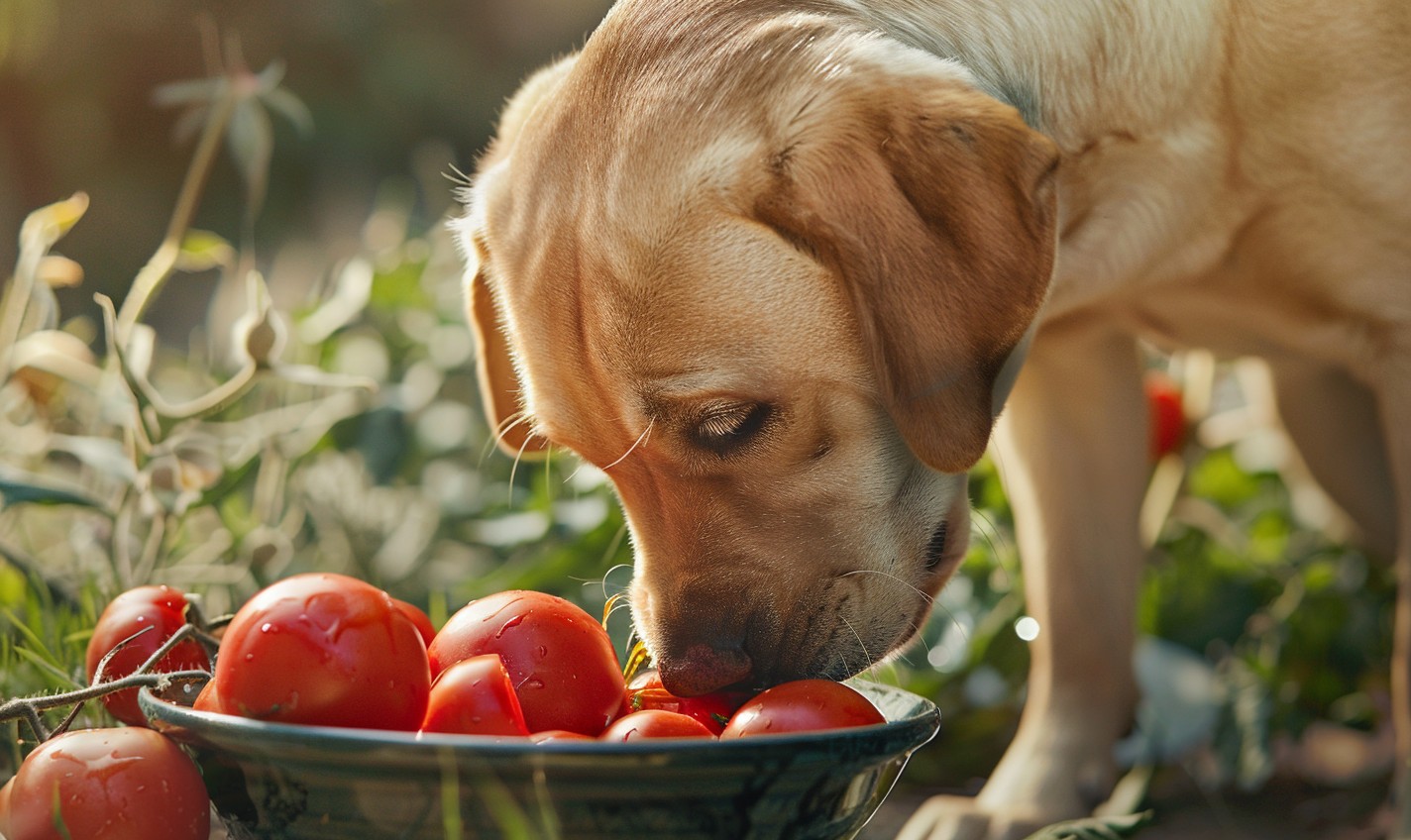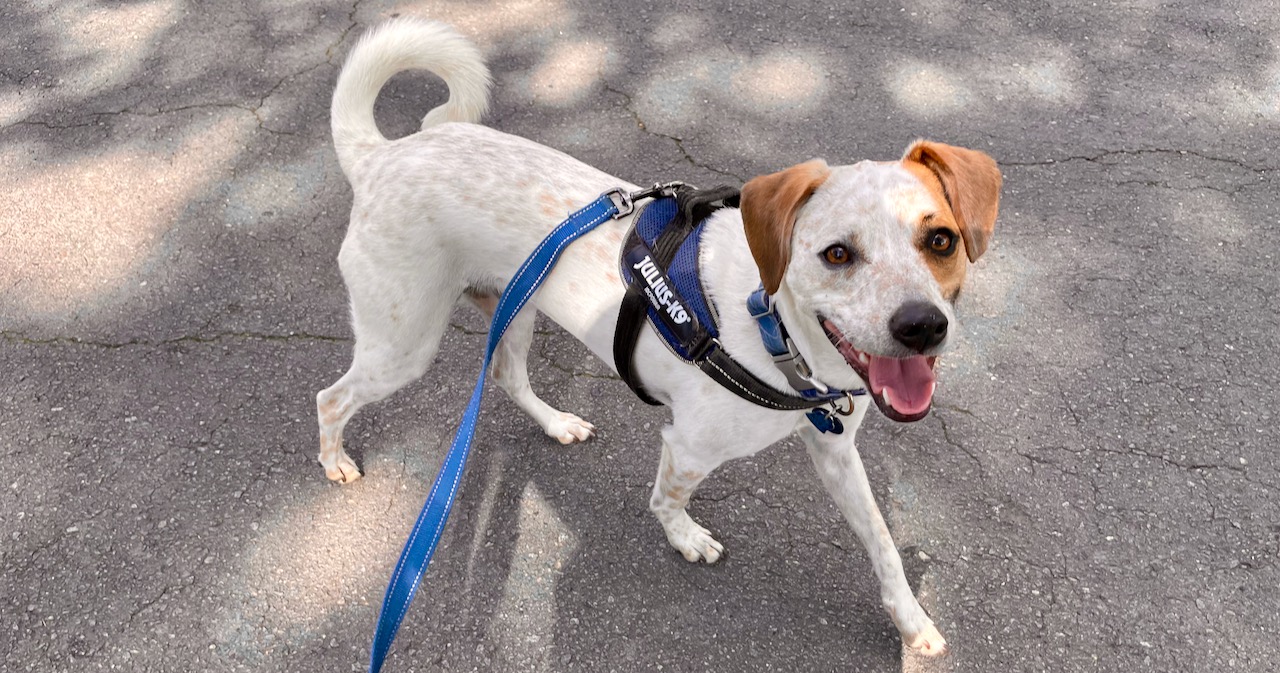As pet owners, ensuring the health and well-being of our furry pals is our top priority. One common question that arises is, “Can dogs eat tomatoes?” The answer isn’t a simple “yes” or “no.” Keep reading to learn which types (and forms) of tomatoes are safe for Fido…and which belong on the “never give your dog this food” list.
Can Dogs Eat Tomatoes?
Tomatoes are a popular fruit (yep, fruit!) known for their rich nutritional profile. They are a significant source of vitamins C, K, and potassium, and they also contain lycopene, an antioxidant with several health benefits for humans.
However, for dogs, the situation is a bit more complex. While the ripe fruit of the tomato plant is generally considered safe in small quantities, other parts of the plant, such as the leaves and stems, contain harmful substances. The key to safely feeding tomatoes to dogs lies in understanding these nuances.
The Good: Benefits of Tomatoes for Dogs
Tomatoes can offer some health benefits to dogs when fed in moderation. The antioxidants found in tomatoes, including lycopene, can support a healthy immune system and reduce the risk of heart disease.
Vitamins A and C are also beneficial for maintaining healthy skin, coat, and vision. Potassium contributes to proper muscle function and fluid balance. However, it’s important to approach tomato feeding with caution to avoid any potential risks associated with other parts of the tomato plant or excessive consumption.

The Bad: Risks of Tomatoes for Dogs
While the ripe fruit of the tomato plant is safe for dogs in moderation, certain parts of the plant pose significant risks. The leaves, stems, and young, green tomatoes contain solanine and tomatine, two substances that can be harmful to dogs if ingested in large quantities.
Signs of Tomato Poisoning in Dogs
Let’s pretend that the worst has happened: Fido has jumped the fence and ended up in the tomato garden. You can’t tell if your tomato plants were eaten or just torn up. Either way…your dog’s teeth marks are evident on the stems.
Some signs of tomato poisoning for dogs include:
- vomiting
- drowsiness
- diarrhea
- abnormal heart rate.
If your dog has any of these symptoms, see a vet immediately! It’s also possible that your dog might be allergic. In that case, anaphylaxis is deadly. Watch out for symptoms like coughing, sneezing, hives, swelling, and heavy breathing that accompanies anaphylaxis and seek help immediately.
Tips for Feeding Tomatoes to Your Dog
So should you toss a tomato slice to your tail-wagger during dinner?
While tomatoes aren’t a canine dietary staple, they can be shared occasionally if certain conditions are met.

Here’s a quick roundup on tips for feeding tomatoes to dogs:
- Ripe is Right: Choose ripe, red, and organic tomatoes as they generally have lower solanine levels with zero pesticides.
- Slice and Dice: Remove stems, leaves, and any green parts before offering a small slice of tomato to your dog. This reduces the risk of toxicity.
- Moderation Matters: Tomatoes should be a treat, not a regular snack. You can get the same health benefits of tomatoes from safer sources in your dog’s diet.
- Be Perceptive to Your Pup: Just like humans, dogs have individual sensitivities. Some dogs might tolerate tomatoes better than others.
Always keep an eye out for any bad reactions after introducing a new food.
If you’re feeling adventurous, check out this Easy Tomato Ice Cube Treat Recipe from Bird’s Eye Maple using ripe grape tomatoes.
Can I give your dog the green parts of tomatoes or unripe tomatoes?
No. Tomatoes have a compound called solanine, which is harmful to dogs in large amounts. There tends to be more solanine concentration in the green parts of the tomato, including the stem, leaves, and unripe green fruits. If your furry pal eats too much solanine, expect them to experience vomiting and diarrhea.
This becomes an interesting obstacle for gardeners who must block access to their outside gardens since the green parts and unripe tomatoes tend to spread and climb on fences while growing.
Purina recommends that “If you grow tomatoes in the garden, your dog may try to nibble on green tomatoes or leaves, stems and vines, so it’s always a good idea to keep these fenced off or inside a greenhouse that they can’t access.”
Can I give my dog canned tomatoes?
Canned foods typically contain preservatives, a high dose of salt causing potential dehydration, and ingredients like onions and garlic, which are highly toxic to dogs. It’s best to skip pasta sauces and soups too, which are usually full of sugar.
Are There Safer Alternatives to Tomatoes for Dogs?
There’s a whole bunch of fruits and veggies that pack the same punch as tomatoes for your dog!
Just remember to introduce new foods gradually to ensure your pup’s tummy remains comfortable.
Here’s a list of dog-approved fruits and veggies:
- Apples are a good source of vitamins A and C, plus dietary fiber. Just be sure to remove the seeds and core first.
- Carrots are like nature’s chew toys! They’re low in calories and high in fiber, making them great for your dog’s teeth and digestion.
- Blueberries are sweet, nutritious, and full of antioxidants for dogs. These little blue gems can help boost their immune system.
- Pumpkins that are plain and cooked are a superfood for dogs. It’s loaded with fiber and can help with digestive issues.
- Sweet Potatoes are rich in beta-carotene and give your dog’s eyesight a potential boost. Just be sure they’re cooked and free from additives.
- Green beans are a crunchy, low-calorie option that adds vitamins and minerals to your dog’s diet. They’re also great for weight management.
- Watermelon can help keep your dog hydrated.
- Peas are another veggie option full of vitamins, fiber, and even protein.
- Cucumbers give a nice crunch and are low in calories. Just remember to remove the seeds before sharing a slice with your pup.
- Spinach can provide a boost of iron and other vitamins. Serve it cooked, as excessive raw spinach might not be easy on their tummy.
- Strawberries are rich in vitamin C. But don’t go overboard – a few strawberries here and there are perfect.
- Cranberries, either fresh or unsweetened cranberry sauce, can help support urinary tract health in dogs.
Remember, always wash and prep these fruits and veggies before sharing them with your furry friend.
And steer clear of anything toxic, like grapes, raisins, onions, garlic, and avocados.
If you’re unsure about a particular fruit or veggie, consult your veterinarian before introducing it into your dog’s diet.
The Bottom Line
To wrap up, tomatoes themselves are not totally bad for dogs if given in small, ripened portions.
All the green parts and unripe tomatoes should be avoided completely due to their higher solanine content.
While tomatoes offer certain nutrients, they should be treated as an occasional treat rather than a daily delight.
If you’re still unsure about whether tomatoes are okay for your dog, it’s best to talk to your veterinarian. They can provide custom advice based on your dog’s health and dietary needs.
After all, a happy and healthy dog is the best kind of companion you can have…even if that means not sharing a bite of your tomato sandwich today!


